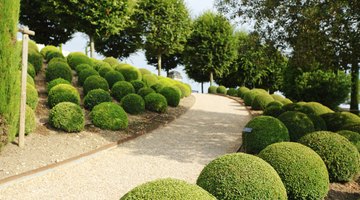When to Prune a Boxwood Shrub
Boxwoods (Buxus spp.) are prized for their dainty, dense, evergreen foliage. Of the 70 species, only two are commonly cultivated, but those two offer hundreds of cultivars to choose from. The littleleaf boxwood (Buxus microphylla) is hardy in U.S. Department of Agriculture plant hardiness zones 5 through 9.

The common boxwood (Buxus sempervirens) is hardy in USDA zones 5 through 8. All boxwoods are pruned in the same manner, but timing depends on the method.
A Little Off the Top
Boxwoods are a common choice for topiary plants and hedges. Their small but tightly packed leaves are simple to trim into shapes. Ongoing maintenance is usually required during the growing period to maintain the height of hedges and smooth the edges of shaped plants. Still, there is a chance that clipping in late summer or early fall might stimulate new growth that can be damaged by winter weather. For this reason, it's best to shape these shrubs in spring and early summer as needed but stop clipping them once fall arrives.
Thin Is In
If you are going to thin out the plant, wait until winter, and do it well before new growth appears. Boxwoods, because of their dense foliage, often die out in the center from a lack of sunlight. About one-third of the bush should be thinned each year, since boxwoods keep their foliage for three years. Using a bypass pruner, reach inside the shrub down to about 6 inches and prune off a few of the inner stems. When you are finished, there should be small gaps along the surface of the bush that will allow light and air to reach the center of the plant, stimulating growth and improving the health of the shrub.
A New Start
If your boxwood needs a serious rejuvenation and you are planning to prune it to the ground, do it in late winter or early spring. Boxwoods pruned in this manner may take a few years to recover. Still, it might be necessary in cases where your shrub has been severely damaged by disease, windstorm or pest infestation. For best results, don't do it all at once. Instead, remove one-third of the branches to the ground, a third the next year, and the final third the following year. As an alternative, remove half the bush to the ground and the other half the next year.
Prepare Properly
Sanitize your pruning tool before you begin to prevent the spread of fungal and bacterial diseases. Fill a container large enough to completely cover the cutting edge of your tool with a solution of 1 part bleach to 3 parts water. Submerge your pruning tool and let it sit in the solution for at least five minutes, then let it air-dry before using it. Do this again before using the tool on another plant.
The Drip Cap
- are prized for their dainty, dense, evergreen foliage.
- The common boxwood (Buxus sempervirens) is hardy in USDA zones 5 through 8.
- Boxwoods are a common choice for topiary plants and hedges.
- Still, there is a chance that clipping in late summer or early fall might stimulate new growth that can be damaged by winter weather.
- If you are going to thin out the plant, wait until winter, and do it well before new growth appears.
Check out this related video from Homesteady on Youtube.
References
Photo Credits
- IvanMikhaylov/iStock/Getty Images
- IvanMikhaylov/iStock/Getty Images
More Articles



